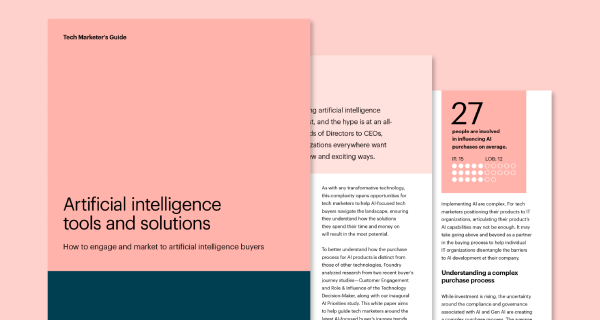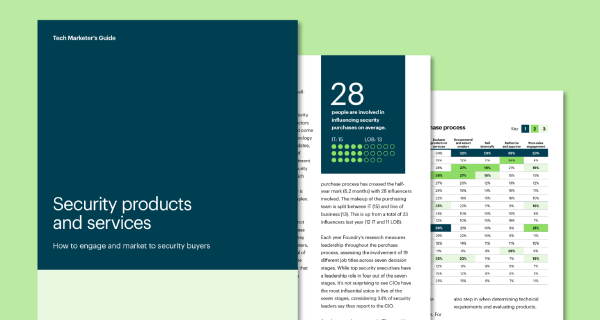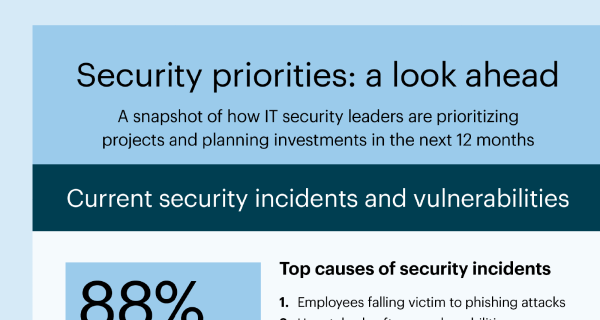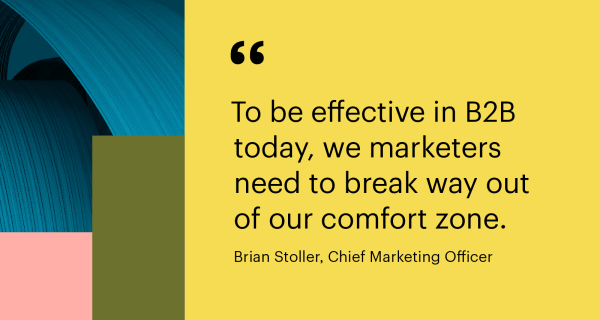Get more from your intent data
Intent data is a powerful tool for marketers and salespeople looking to drive revenue for their organizations. However, actually making intent data actionable is among B2B marketers’ top challenges.
Intent data helps you identify and understand the behaviors of those actively, or about to be, in-market; so you can strategically tailor your messaging, target your outreach efforts, and optimize your engagement strategies. Yet, unless you can effectively turn intent data into actionable insights and strategies, its potential remains untapped.
Once you have intent data, how can your organization harness its full potential and create actionable strategies? We’ve created a comprehensive guide to understanding and activating intent data across marketing and sales activities, along with an easy-to-use strategy template to get you started.
Get your intent strategy template
What is intent data?
Intent data is information that captures an account’s digital behavior and provides insight into their interests, needs, and purchase intentions. It can include data such as website visits, search terms, content downloads, social media activity, and more.
The goal of intent data is to provide marketers and sales teams with a more complete understanding of a potential customer’s behavior and preferences, allowing them to deliver more targeted and personalized communications. By analyzing intent data, companies can gain a deeper understanding of their target audience, prioritize sales leads, and develop more effective marketing strategies.
The types of intent data and their benefits
First-party intent data
First-party intent data pertains to information originating directly from your own digital channels and customer interactions. These interactions could be page visits on your website, content downloads, and data from your CRM. First-party data is important because:
- It’s uniquely yours.
- You’re likely spending money to drive traffic to your website.
- That audience is already aware of your brand and offerings.
Only 2% of buyers fill out web forms, so by waiting for your website visitors to complete a form, you risk leaving money on the table. Capturing first-party data helps your marketing spend go further by adding insight into activities from the audience you’re already paying to reach for retargeting, dynamic messaging, and prioritization.
Second-party (or proprietary) intent data
Second-party data is sourced from another company’s first-party data that you obtain directly from them. Acquiring second-party intent data can be done by purchasing it directly or through a data partnership. Review sites like G2 are a clear example of second-party intent data. These providers analyze their site activity and provide relevant in-market activity signals to their customers.
Second-party intent data combined with your first-party intent data provides a broader perspective on customer behaviors and interests. This broader audience understanding helps you expand your reach and attract new prospects.
Third-party intent data
Third-party intent data revolves around how users interact with the digital channels an organization doesn’t control, such as publishing networks, external blogs, online
forums/communities, social media, and other public web sources. In comparison to first-party signals, third-party data signals typically occur earlier in the buyer’s journey, making these signals best for reaching leads early in the decision process.
Most third-party intent vendors look at data from content engagements on publisher sites they’ve built relationships with. However, vendors collect third-party intent data across millions of sources, such as websites, public forums, SEC filings, data co-ops, ad networks, social networks, etc.
Purchasing third-party intent data can help B2B marketers discover and target audiences who may not be visiting their websites but are in-market to buy based on their outside research. By capturing this data, you can drive demand from buyers who might not even be aware of you yet, make yourself top of mind, and, ideally, convert them.
Foundry Intent adds a comprehensive lens by showing intent across the places buyers make decisions based on your specific, relevant triggers.
See how Foundry does intent differently.
Getting started—how to activate intent
Define your goals
Before you can begin activating intent, you need to clearly outline your objectives for using intent data. Are you aiming to improve lead generation, personalize marketing campaigns, enhance sales prospecting, or something else? Having specific and defined goals will help you focus your intent data efforts and measure success properly.
What are some of the common goals marketers have when using intent data? Foundry found that marketers primary goals for using intent data includes:
- Align sales and marketing
- Prioritize prospecting
- Identify new prospects to target
- Monitor potential customer churn
- Tailor messages based on intent topics
Following standard practice, goals should be specific, measurable, attainable, realistic, and timely. An example could be “Increase email click-through rates (CTRs) by 20% in H2 for our healthcare software product among potential customers actively researching healthcare solutions.” Having clearly defined goals will make the activation and implementation of intent data simpler and more effective.
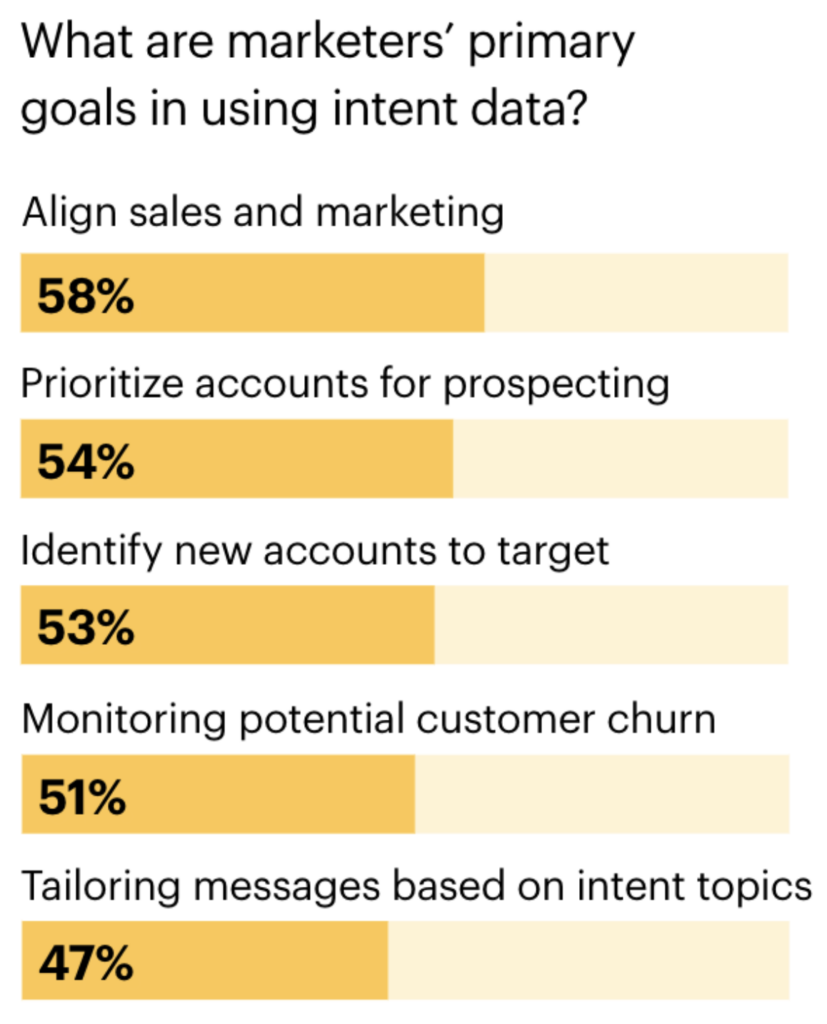
Define your ICP
ICP is a critical part of any intent driven strategy. Your ICP will ultimately guide your intent data strategy by serving as the blueprint of the type of prospects or accounts that are most likely to benefit from your product or services.
Identify intent data sources
A single buying decision involves many people, channels, and actions. Think about the last time you bought anything, whether It was software, a car, or even a new pair of sneakers. When buying sneakers, you probably read reviews online, researched prices on a few websites, clicked on a retargeting ad, and asked your friends their opinions. Regardless, you likely didn’t click the first link on Google and press the big shiny “Buy Now” button. Looking at one action isn’t enough to know you were picking out those sweet new kicks.
The same goes for intent data. One signal is not enough to understand what your potential buyers are up to. Given that intent signals come from many different channels, sources, and interactions—you want as many reliable data sources as possible to provide the most straightforward and reliable visibility into the buyers’ journey.
So once you have all these intent data signals and sources, how do you turn that into actionable insights? Two ways:
- Use an intent data tool. Multi-source intent tools deliver a full picture of the buyers’ journey to provide comprehensive insights for data activation without the manual task of aggregating it.
- Aggregate, normalize, and analyze data in-house.
Since data comes in all shapes and sizes, many vendors define and deliver intent differently. From there, it’s up to the end-user to normalize and combine it based on their needs. It is possible to combine data sources through CRM or marketing automation integrations; just be sure you have a process for field mapping across sources and maintaining the history of intent signals associated with each account.
Knowing which accounts to target makes for more precise, relevant targeting and helps the budget go further on intent-led strategies like ads, account-based marketing (ABM), or outbound sales. A cohesive data flow is crucial to what you can accomplish. Typically, the more accurate data points you can associate with an account, the better, especially if you rely on property overlap to layer data from different sources.
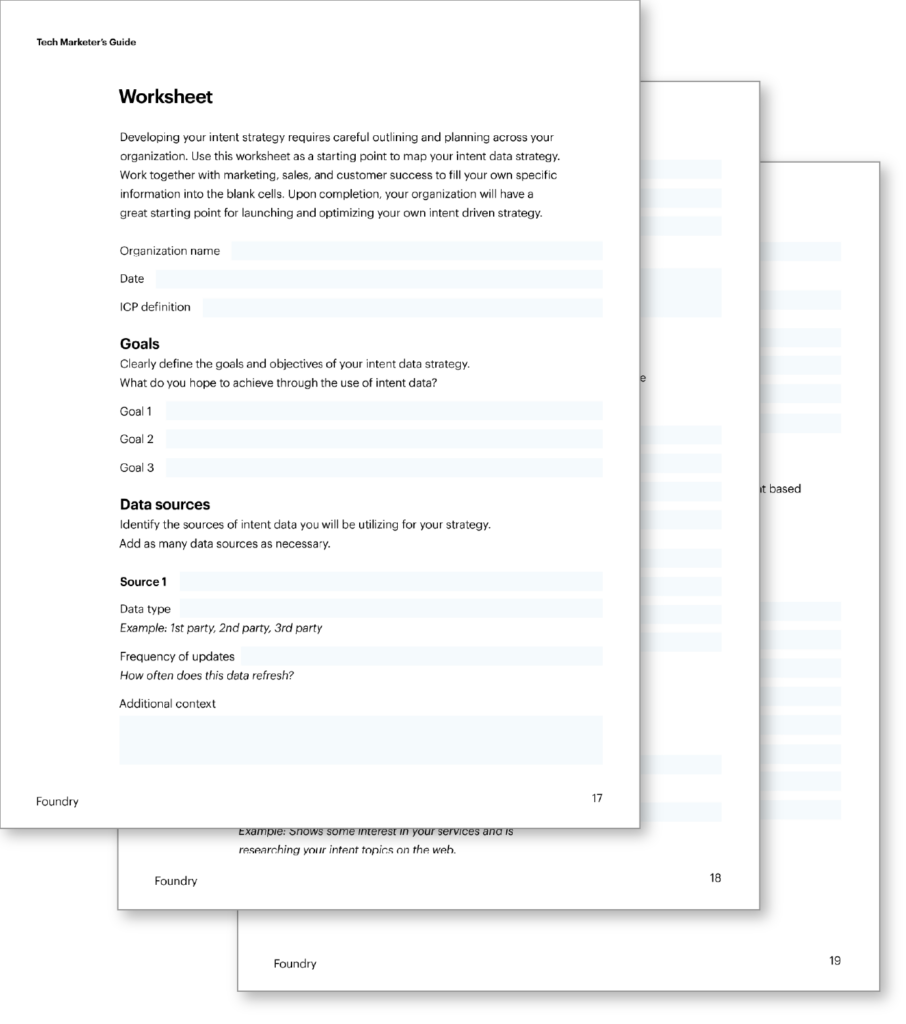
Connecting the dots
Audience segmentation
You can’t effectively act on intent data without first segmenting the various signals to arrive at meaningful insights. Distributing intent insights to relevant teams does little unless those teams are educated on how best to act on them. Further, if the digestion of data and distribution of insights takes too long, the intent data may no longer be relevant.
To make your data actionable for teams, you must segment your core audiences by their interests and recognize their differences. This allows you to craft messaging and select channels based on what resonates best with that group. The basis of an effective sales or marketing channel is often built on this kind of intelligent, meaningful segmentation, such as firmographics or persona-specific criteria.
Segmenting your audience
The following are standard fields to consider including in segmentation and activation. Using these fields, you can assign specific intent signals to their segments. Once you’ve segmented intent signals, you can then dive deeper into understanding their needs and the best approaches for marketing and sales activities. The real power is the ability to dive deeper and understand not just who these core audience segments are but their priorities. Intent data puts that knowledge directly in your teams’ hands, in real-time.
| Company properties | Buying team properties | Intent properties |
|---|---|---|
| Company name | First name | Intent source |
| Domain | Last name | Intent signal |
| Industry | Location (when available) | |
| Company size | Intent or lead score | |
| Location (when available) | Phone | |
| Job title | ||
| Location (when available) |
Diving deeper: Understanding audience segments
Once you’ve identified your core audience segments, it’s time to dive deeper into understanding each segments’ needs and mapping messaging that resonates with them. Segments that are looking for general awareness need to get to know your solution and your brand compared to audiences engaging with competitors who may be more interested in how you’re different, why you win, or what your customers love about you.
Intent data aims your marketing towards the most relevant targets and highlights what may resonate based on their engagements. For example, consider a network security provider. If a company is exhibiting intent signals related to researching advanced firewall solutions or cyber security protocols, you might have better luck tailoring your outreach with content about enhancing network protection versus generic messaging.
Segment preferences
For example, here is one way you could break down segments preferences by varying levels of intent.
| Competitive engagement | Hiring | Web visits | Signal themes | Score |
|---|---|---|---|---|
| Social proof, testimonials, case studies Speak to the ways you win, and USPs | Content related to hiring/growing teams, such as: benchmark reports, onboarding checklists, templates | Resources related to viewed content Answer FAQs about pages they visited (How it works, pricing, product, etc.) | Related topical content Tailored value propositions | Tier scores and determine the type of content, channel, and number of touchpoints best suited to each score level. (See below for our best practices when scoring different intent ranges.) |
Best practices for different score ranges
- 80-100: These companies are showing significant increases in likelihood to purchase and should be prioritized for direct marketing, outbound lead gen, and sales prospecting.
- 60-79: These companies are showing an increased likelihood to purchase and can be included in advertising campaigns for top funnel nurture or reached over email and social channels.
- 40-59: These companies are showing modest purchase signals. Nurture leveraging unpaid channels, in particular website personalization and email marketing.
- 0-39: These companies have not demonstrated any meaningful purchase intent signals. Ignite their interest in the topic with quality content and relevant business cases.
Activating intent data for marketing
Making sure you’re reaching the right people with the right messaging and the right timing seems like a no-brainer, but it’s easier said than done. Let’s break down how to tailor your marketing efforts to address the unique needs and preferences of each segment:
Ad targeting and retargeting with intent
Why waste resources showing ads to people who have no interest in seeing them?
Building audiences based on intent data is a game-changer for improving ad efficiency and getting your ads in front of in-market buyers. Intent-based audiences are a fresh targeting dimension to improve conversion rates and lower cost-per-click (CPC). This is possible on Google Search Ads, paid social channels like LinkedIn, Facebook, Instagram, or Twitter, or any platform that enables custom audiences.
To set up intent-based ad targeting, evaluate the data you have on hand. If you’re able to customize your intent triggers, consider broadening them for general ad audiences. Volume isn’t a bad thing for ad targeting if you know everyone on the list is a fit and likely in-market. For example, hiring signals for roles like “technology marketers” will result in high volumes of data, but if expanding marketing teams is relevant to your business, they’re probably all relevant. This quantity could be too much for your outbound team, but the volume is perfect for building ad audiences.
Try creating an audience with lower- funnel intent signals to take it one step further. For example, your team could show audiences engaging with “lead generation software” or “engaging with competitor X” product-focused or social proof ads which may also be worth higher bids. Double-check that you can build a large enough audience for targeting minimums if you’re going down this path.
Setting up intent for ads:
- Choose your topics and keywords: An easy place to start is to take a look at which keywords and topics perform well on Google Ads and organic search. Add those topics and keywords to be captured by your intent provider. Also include any other adjacent keywords around your solution, best use cases, and any topic or problem an ICP might be engaging with or trying to solve.
- Set up your personas: Who do you want to click on your ads? Try to keep this a little broad. This serves two purposes. One is a brand play. Eventually, junior marketers move up. You want to have a permanent home in their brain whenever they’re thinking about the problems you solve. The second is that word travels fast, so create a killer offer and let teams talk.
- Automate your delivery: It may be easier to get your first few deliveries as CSV files so you can edit and optimize intent signals and audience filters before having them delivered directly to your CRM or marketing automation tool. While, this depends on your workflow, receiving intent data on a weekly basis is a great place to start.
- Normalize your data: Before passing data on, edit and update CSV columns to match exactly what the custom audience import instructions say in your chosen ad platform(s).
“Intent data at its core helps predict the likelihood of an organization being in-market for a specific solution at a given time.”
Tukan Das, VP of Product Management at Foundry
Retargeting
Dynamic ad retargeting based on your website visitors strengthens brand awareness and drives engagement among visitors who showed interest but didn’t convert. Thanks to intent data you can take ad retargeting a step further. With intent data, you have the tools to understand buyers’ needs and re-engage them with messaging that speaks directly to their pain points.
First-party intent signals identify the companies visiting your website and provide the firmographic data you need to put the right ad in front of them at the right time. These audiences can be segmented by which page(s) they visited, firmographic details, or a mix of intent data and CRM insights.
How to set up website intent audiences:
- Identify your visitors: Who’s visiting your site but not converting? Who’s visiting and in an active deal? Are customers actively on your site, and what are they looking at? This will determine your channels and messaging for engaging these audiences.
- Upload or integrate: Normalize the data, then upload it to your chosen ad platform(s) or directly into tools like Google Analytics for dynamic targeting.
- Adjust your bid strategy: Determine which audiences are worth higher bids. Firmographic traits like higher employee headcount or annual revenue are a great place to start. To take it a step further, consider which page visits are valuable to your business and double down. For example, a prospect that visited your site multiple times or spent time on the pricing page may be more likely to convert versus a prospect that only visited your homepage.
- Set up suppression lists: There are likely audiences that you don’t want to show ads such as out-of-market prospects, competitors, people that work at your company, or existing customers. By only showing ads to in-market companies, you can save money while improving conversion rates and passing more relevant leads to your sales team.
Tailored content journeys
Informed content
90% of leading marketers say personalization significantly contributes to business profitability. So how exactly does intent data give your content a personalized touch? The key is to track what type of content each of your audience segments are most engaged with. After identifying audience segments based on varying levels of intent, you can then use additional intent insights to tailor their buyer journeys.
However, developing content specific to your prospects’ challenges requires you to know a few things about who you’re targeting. That’s where intent data can help you dig even deeper by:
- Selecting the right content: What content resonates with your buyers? Intent data reveals the types of content that resonate most with particular audience segments. By analyzing which topics, formats, or channels prospects engage with, you can suggest relevant content that aligns with their interests.
- Identifying content gaps: Are there any gaps in your current content? Use common intent signals to generate the most useful content ideas and identify gaps in existing content.
- Personalizing content: Get personal with prospects. With intent data, marketers can deliver personalized content to each segment. Content can be tailored to address specific pain points, challenges, or preferences of the audience. Personalized content resonates better with buyers and increases engagement.
It’s also important to look at your recent customers. How were they spending time online before buying? Use these data points to inform the content on your site, across your campaigns, and wherever else your buyers spend time. When organizations are able to identify the information that prospects care about, they can proactively speak directly to potential buyers.
Dynamic web personalization
Personalizing content and messaging based on buying behavior significantly drives engagement and increases web conversions. In fact, 80% of consumers are more likely to buy when brands offer personalized experiences.
Platforms such as Adobe Target, Google Optimize, and Foundry ABM can use intent data and firmographic information to deliver relevant, tailored content to website visitors. Their experience can be customized down to modifying welcome banners, navigation menus, and CTAs. With intent built into dynamic personalization, you know when to show social proof, when to show different pricing packages, and when assets like guides or templates are the most valuable. This is a great chance to experiment and get creative.
For example, if you target a range of company sizes and industries, firmographic data can help you show the appropriate solution or messaging for each type of visitor. Or, if you know they’re engaging with a competitor, you can include specific features and value propositions on that page to resonate clearly.
Steps to setting this up:
- Segment your audience: Segment prospects by firmographics or intent data based on how you plan to customize your pages.
- Set up templates: In your CRM, marketing automation, or chosen ABM platform, create landing pages with customizable CTAs, banner images, redirects, you name it. Keep in mind the behaviors and firmographic dimensions you’re targeting. For example, if a prospect engages with your competition, set up your website to redirect them to a competitive analysis landing page automatically.
- Monitor and optimize: Monitor metrics like total page views, page clicks, conversion rates, and time on page to understand what is resonating and optimize accordingly.
Email marketing
Gone are the days of generic emails. Intent data takes email nurturing to the next step by allowing marketers to tailor their email campaigns for better engagement and conversion. Let your
email marketing shine by molding it to fit your audience without drowning in manual list building and CRM data hygiene.
Based on buying behaviors, marketers can use custom creative, copy, and cadences. By marketing in a way that fits what they’re looking for, prospects are more likely to find your content valuable and interact with it. This helps your audience feel like they’re more than an email in a CRM.
Steps to setting this up:
- Determine the most relevant segments based on intent data.
- Map messaging to each segment: Segments looking for general awareness need to get to know your solution and your brand, compared to audiences engaging with competitors who may be more interested in how you’re different, why you win, or what your customers love about you.
- Build and connect your email cadences. What must happen for someone in a general awareness audience to transition into a competitive research audience? What timing or triggers must your team consider to ensure messaging stays relevant to that prospect? Maybe more than five visits to your website, a jump in intent score, or new competitive engagements identify a time to evolve the messaging.
- Analyze and optimize. This is an iterative process, and you’ll see the most success if you remain open to experimentation. As you monitor results, you’ll learn when certain messaging resonates with each segment or in each buying stage.
Activating intent data for sales
How should you make intent data actionable for your sales team to drive results?
Inform prospecting, prioritize outreach, tailor personalization, and improve relationships with current deals and customers. Intent helps you identify who’s buying early on, what your active deals care about, and how to create an order of operations when managing your sales process.
Prospecting with intent
Why guess who your buyers are when you could know for sure? Imagine the time you could save and the increased opportunities for valuable interactions with potential prospects. Historically, prospecting has been tied directly to a company’s perceived fit to an ICP. However, this is just one piece of the puzzle, and on its own, this model doesn’t consider whether prospects are in-market. Intent data paints the full picture, allowing sales reps to know exactly who is in-market and how to:
- Choose the right channels: Select the appropriate communication channels for your outreach, such as email, social media, or phone calls. Match the channels to the preferences of your segmented prospects.
- Time outreach: Use the timing of the intent signals to your advantage. Reach out to prospects when their interest is at its peak, increasing the chances of engagement and response.
- Nurture and follow-up: Implement a structured nurturing process for prospects who show intent but may not convert immediately. Use a combination of automated and personalized follow-ups to maintain engagement. Intent helps you identify where prospects are in the buyers’ journey. With intent in your arsenal, you can proactively engage those in the exploration and comparison stage before your competition does, shortening the sales cycle and winning more business.
Trigger personalized outbound
Outbound is best when it’s short and sweet. You don’t need to close the deal in your first email. Rather, you should showcase how you understand their pain points and pique their interest in what you offer. Intent data streamlines this process, allowing sales reps to use specific and personalized outbound efforts towards prospects actively seeking to make a purchase.
To make these insights actionable, match a prospect’s intent signals to a relevant outbound sequence. Use specific value propositions, choose relevant resources, and trigger certain touchpoints around a buyer’s intent signals. For example, maybe they’re in an nurture-based sequence, and now they’re spending time on your pricing page; it could be a good time to notify the rep to send a quick video walkthrough of your packages. Knowing what they’re looking for, where, and when lets you immediately provide as much value and relevance as possible.
How to set this up:
- Set up alerts: Notify sales when key activities or signals are taking place via email or integration to your CRM, marketing automation, or other martech tools. This helps your team act quickly with pre-drafted content. Some good triggers to set alerts for, include: visits to your pricing page, competitive comparisons, multiple web visits (or multiple people within an account visiting), or an increase in intent score.
- Queue up content: Create email templates, LinkedIn DMs, short videos, or a folder of relevant resources for each alert.
- Add personalization: Once you receive your first notification, add personalization, such as: the prospect’s name, title, industry, or intent signal. If you want to stand out, more personalized is better. You’re saving time prospecting, so focus on meaningful outreach. Nothing puts the “cold” in cold email like a copy-pasted message.
Intent for marketing and sales alignment
Intent scoring
Intent scoring empowers teams with intelligent, dynamic prioritization that goes beyond firmographic scoring. Sales and marketing teams should collaborate together to determine how intent scores fit into existing scoring models in their marketing automation, sales engagement, or CRM workflows. Once a process is defined, integrate it into existing workflows for seamless, dynamic prioritization.
Marketing and sales teams often use scoring tiers when determining the highest quality prospects. Here’s an example of what a scoring tier based on intent could look like:
- 80-100: These companies are showing significant increases in likelihood to purchase and should be prioritized for direct marketing, outbound lead gen, and sales prospecting.
- 60-79: These companies are showing an increased likelihood to purchase and can be included in advertising campaigns for top funnel nurture or reached over email and social channels.
- 40-59: These companies are showing modest purchase signals. Nurture leveraging unpaid channels, in particular website personalization and email marketing.
- 0-39: These companies have not demonstrated any meaningful purchase intent signals. Ignite their interest in the topic with quality content and relevant business cases.
This allows both teams to ask questions such as, “Are there other complementary actions, such as engaging with ads, that when paired with an intent score above 90 the lead is passed directly to sales? Or a type of content view and a score above 70 that enrolls a prospect into a lower-funnel ad audience?”
Based on intent scoring, intent insights are categorized into different tiers, enabling your teams to prioritize their efforts effectively. High-scoring leads with significant intent signals and engagement can be fast-tracked for more personalized sales interactions. While on the other hand, lower-scoring leads may require further nurturing through marketing campaigns. This approach ensures that both marketing and sales resources are allocated optimally.
Prioritization
According to Foundry, more than 90% of marketers said they use intent data scoring to prioritize accounts, identify content to be served, and build target account lists.
Prioritization based on intent is a clear connector between marketing and sales. Collaborating on how intent plays into scoring and the handoff process builds team trust and creates a feedback loop. Sales teams are motivated to relay lead and messaging performance to marketing teams, and marketing teams are incentivized to act on that feedback.
Using intent data enhances lead scoring relevance and accuracy, so marketing and sales teams can prioritize based on buying behavior. Intent-based scoring brings highly engaged prospects to the top of the list and informs the best next steps. Focus on the most active prospects in real-time. Since these accounts fit your ICP and are showing a propensity to buy, they should be contacted by your team first. Most intent data providers offer intent-based lead scoring to use independently or as a factor in your existing score.

Account tracking
A lot of ABM programs fail to prioritize their spend on the right accounts, but with intent data you can eliminate this obstacle. While intent data is commonly associated with identifying new potential customers, its value extends far beyond this initial phase. You can use it to keep track of activities and prioritize named accounts, so you know when to double down on existing opportunities and when to shift your focus to more promising prospects.
There are two primary audiences to do this with:
- Target account lists: The core of ABM lies in the relationships with specific high-potential accounts. Here, intent data guides your actions by monitoring intent signals within your designated target account list. These insights provide a dynamic understanding of account activities, interests, and engagement levels. Monitoring intent signals on your target account list helps you know which accounts to focus on and how to engage them best. Use signals to trigger sales or marketing steps like a phone call or enrollment in an email campaign to reach buyers more dynamically.
- Existing clients: For existing clients, following their buying behavior helps know when an account is either a) potentially ready for an expansion or b) potentially unhappy and needing a check-in. Armed with this knowledge, you can swiftly address concerns, ushering in timely interventions that strengthen relationships and curb potential churn.
Measuring success
How should you measure the success of your intent data efforts?
It’s important to continuously measure the success of your intent data strategies and efforts. When it comes to optimizing your intent data activation, the metrics you track are paramount to your growth and overall success. We recommend measuring your strategy based on these insights:
- Engagement rate: You should notice a boost in your engagement rates as prospects are interacting with more targeted content and campaigns. Measure how effectively these are engaging your target audience. Look for metrics like click-through-rates (CTR), open rates, and content downloads.
- Lead quality: Assess the quality of leads generated through intent data. Are they aligning with both marketing and sales expectations?
- Conversion rates: Measure the percentage of leads influenced by intent data that convert into customers. Compare this conversion rate with other lead sources to evaluate the effectiveness of intent data.
- Return on investment: Calculate the ROI of your intent data initiatives by comparing the revenue generated from intent-driven activities against the costs of acquiring and utilizing the data.
Conclusion
Transforming intent data into actionable insights marks a critical stride in maximizing its potential. Research shows campaigns using intent-based targeting were 2.5x more efficient than campaigns using standard targeting dimensions.
We’re in an era where simple lead lists aren’t enough. To keep up in the market B2B organizations need to reach buyers first—by knowing exactly who’s looking, what they care about, and how engaged they are in the buying process. When digested properly, multi-channel intent provides you the insights to act on buyers’ needs dynamically. This involves tailoring content, selecting channels, and determining the cadences, to align with your buyers’ priorities and their specific points in their buying journey.
Now that you’ve read our guide on understanding and activating intent data across marketing and sales activities, download our customizable template for outlining, segmenting, and prioritizing your own intent data strategy.


